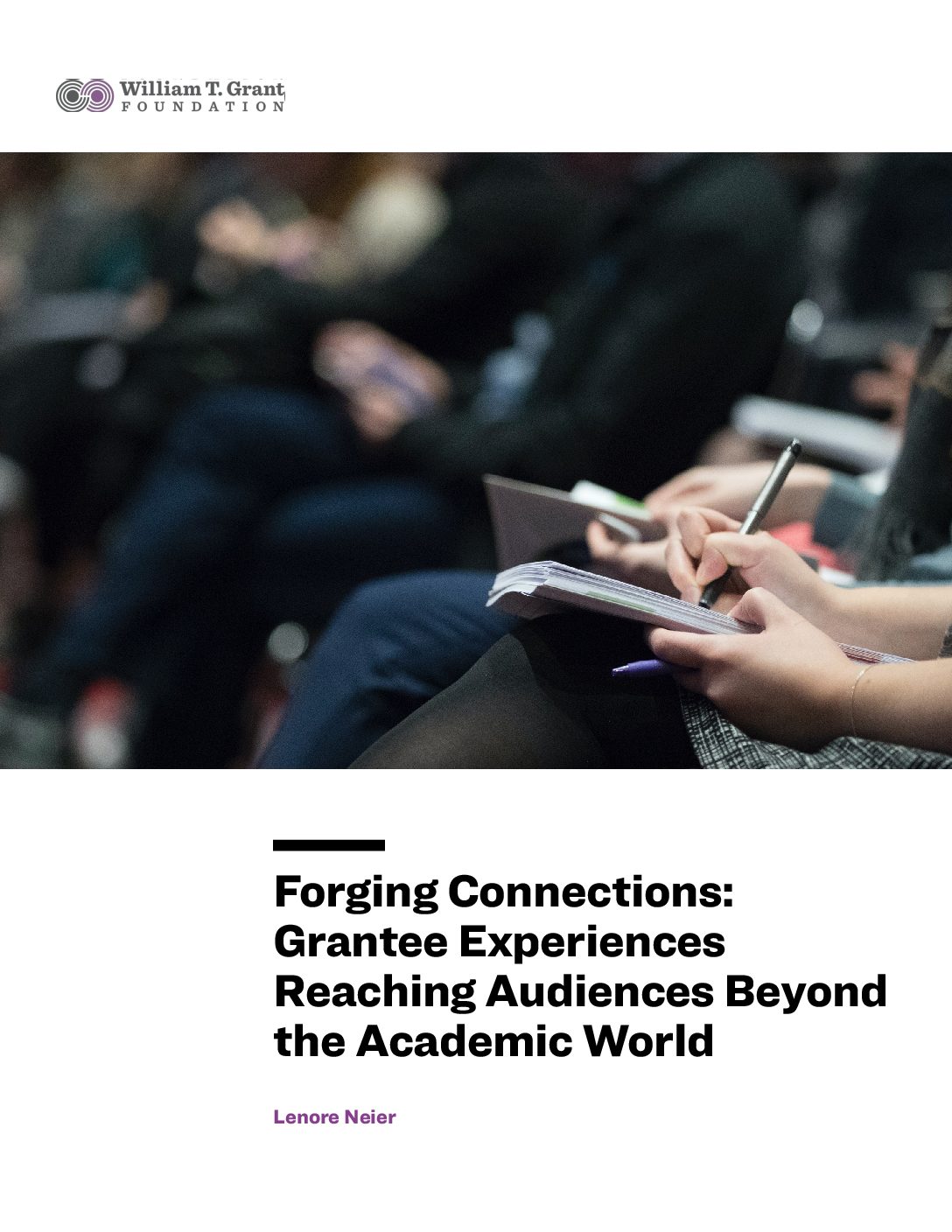Last year, the William T. Grant Foundation took stock of our initiative to support research on reducing inequality in youth outcomes. We wanted to understand, in part, the pathways through which grantees’ research findings may be reaching audiences including researchers, journalists, policymakers, and practitioners. Five years into the reducing inequality initiative, what evidence did we have of such reach, and what signs were there that the funded research was relevant and meaningful to subsequent research, policy, and practice?
Taking Stock
Our review showed that we’re funding a diverse, highly accomplished group of researchers who are carrying out rigorous studies that span policy domains. Despite the relatively early stage of the initiative, several studies have yielded causal information about programs or policies that reduce inequality. Others have identified promising mechanisms for reducing inequality that could be tested in future research. On a number of measures, grantees appear to be leading voices in their disciplines and research areas.
To explore engagement with broader audiences, I reviewed the communication and outreach activities of all major research grantees and William T. Grant Scholars whose studies focused on reducing inequality (67 as of December 2019). On their annual reports, nearly half reported forging connections beyond academia through communications activities such as writing op-eds, providing radio and television interviews, drafting policy and legal briefs, and participating in legislative meetings.
For a deeper dive into these activities, I interviewed a subset of grantees who had reported outreach activities external to the research community. Because of the relatively early stage of the initiative, I didn’t necessarily assess direct use in policy or practice—rather, I sought evidence of steps along the way. I was especially attuned to indicators that the research we are supporting is connecting with people beyond research circles and that grantees are laying the groundwork for broader engagement.
Relevant and Meaningful Research
Grantee reports of their experiences echoed what we’ve learned from research on conditions that facilitate the use of evidence (much of which has been funded by the Foundation in our use of research evidence focus area). For instance, we know that for research to be used, it needs to be relevant: It needs to illuminate questions and answers that matter. As my colleague Vivian Tseng has written, relevant research is “in dialogue with existing ways of defining problems and solutions, not in a separate academic dialogue” (2017). Although the researchers I spoke with are at different stages of their career and at different points in their grants, they all reported similar qualities and processes consistent with this approach to interacting with policy makers and practitioners, listening and responding even as they bring relevant evidence to light.
Awareness
Building awareness through media coverage can help shape the public’s understanding of issues that are central to the research. Importantly, among those grantees that are reaching wider audiences this way, media coverage is not as an end in itself, but as a means of opening avenues for future collaboration with stakeholders on the ground.
— Amy Hsin
—Bruce Baker
Relationships
Beyond building general awareness through the media, forming relationships that allow for direct engagement with those for whom the work is most relevant is an essential component in creating pathways for research use and ultimately making an impact. As Kim DuMont has written: “Relationships shape what research evidence individuals and organizations acquire and how they make sense of it” (2015). Recent findings indicate that research is more likely to bring about change when those who are putting it into action have the “opportunity to learn from research-based ideas, [are] assisted by others, and [have] opportunities to respond to and deepen understanding of challenging ideas” (Honig et al., 2014). By being generous with their time and knowledge, grantees have built trusting relationships that help to support a nuanced understanding of research and make it more likely that it will be used effectively.
—Carolyn Heinrich
—Alicia Modestino
—Mark Courtney
Mutuality
Grantees also reported that these relationships are most productive when they are based on principles of mutual exchange and reciprocity. That is, when researchers are able to incorporate the information needs of policy or practice partners into their studies, it helps to ensure the relevance of the work while also building trust and respect. As Vivian Tseng writes, “Two-way streets can foster a cycle of iterative work, of practice to research and back” (2015).
—Carolyn Heinrich
—Laura Hill
—Alicia Modestino
Understanding
Finally, building on the idea of two-way streets, recent work on the “social side” of evidence (Dumont, 2019) underscores that research use isn’t a simple transaction, but a matter of deliberation, discovery, capacity building, and enlightenment. Researchers are most able to make an impact “when they influence how policymakers think about an issue,” not necessarily “what they think” (Yanovitzky & Weber, 2020). Our review found that grantees who are building a broad base of relevant findings are well poised for such influence:
—Daniel Schneider
—Laura Hill
Conclusion
In keeping with our mission to support research to improve the lives of young people, we’ve taken on the challenge of reducing inequality in youth outcomes by bringing the best possible research to bear on the problem. After five years of supporting this work, we’re proud of the body of work that grantees are producing. We’re also inspired by their efforts to inform thought and action beyond the university gates.
We’ve seen that grantees are advancing their work in both broad-brush and more targeted ways. They’re building relationships built on mutuality and trust, leading to collaborative partnerships, greater respect and understanding of the research, and in some cases, instrumental use of the findings.
To grantees and potential grantees reading this essay: As a communications unit within the Foundation, we are eager to help amplify your voices. We commonly work with grantees to produce original web content, promote writing you’ve published in the academic or popular press, and call attention to your contributions in social media. In addition, the Foundation maintains a working relationship with outside groups that support researchers in communicating with the public and engaging policymakers, and we can help make these connections for you.
Looking ahead to another five years from now, we hope to see even more grantees studying strategies for reducing inequality, engaging with audiences outside the academic world, and helping to bring the insights of research to decision makers who can act upon them.













